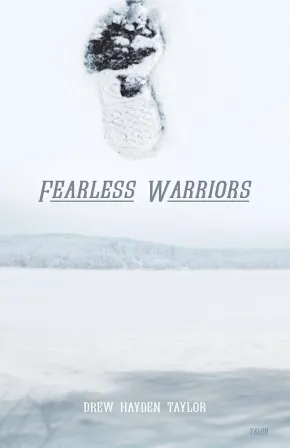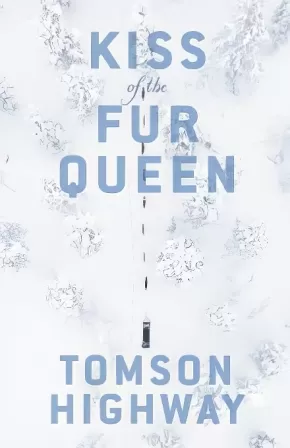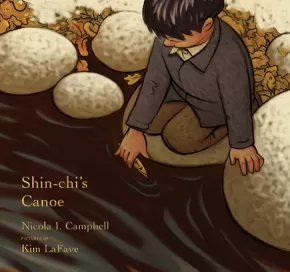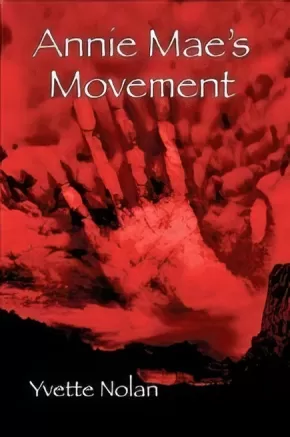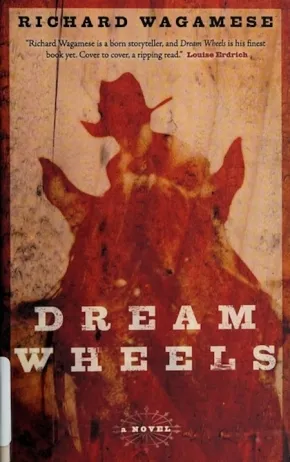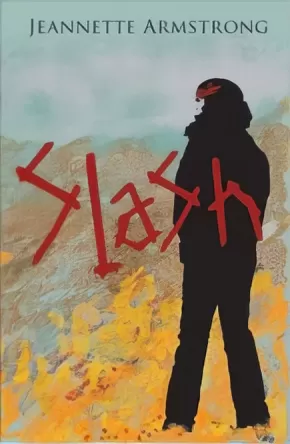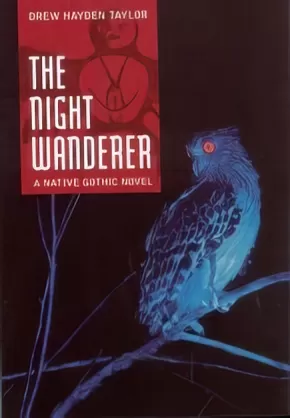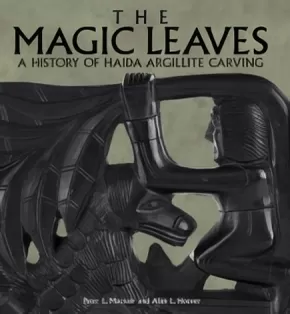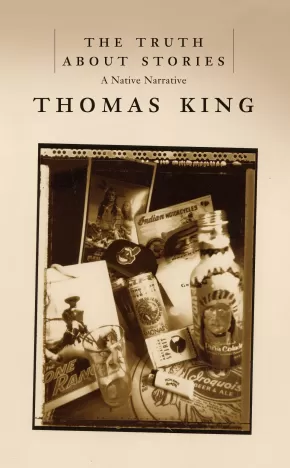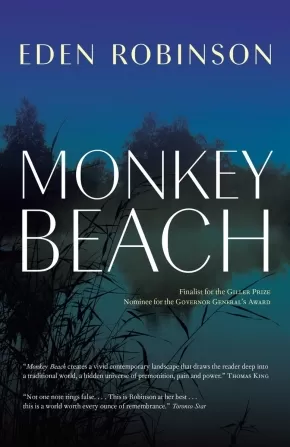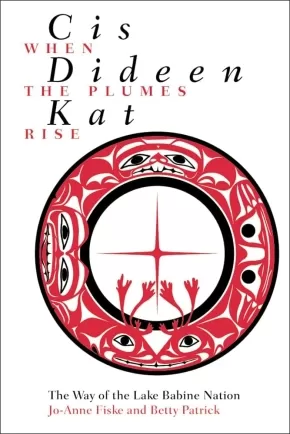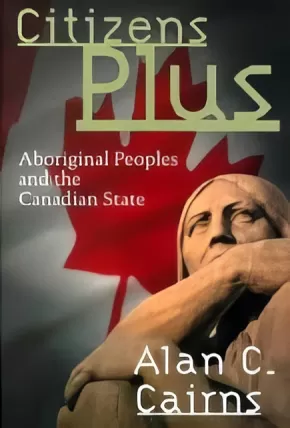Canadian Indigenous Courses
Synopsis:
Taylor's powerful, haunting and incredibly entertaining stories in Fearless Warrior are a full frontal assault on stereotypes of all kinds--an edifying affirmation of humanity unlike anything else. More than anything else, these stories shine with a wisdom, an understanding of the human condition, that is rare among writers courageous enough to take on these themes.
Internationally acclaimed as a playwright, screen-writer, comic and sardonic commentator on the endless gaffs, absurdities and the profound and painful misunderstandings that continue to characterize social interactions between aboriginal and non-aboriginal peoples, Taylor’s stories in Fearless Warriors are a full frontal assault on stereotypes of all kinds and an edifying affirmation of humanity unlike anything else in fiction.
Each of these stories is as remarkably different in terms of its unique narrative tone, origin and direction, as are the characters of his plays, making Taylor’s singular collection of fictions quite intentionally much more than the sum of their parts. By degrees dramatic, shocking, tender, chilling, affirmative and tragic, each story takes on a different cliché or “common sense understanding” of inter-racial and inter-cultural relations, all of them suffused with the incomparable wit, gentle and generous humour, mercilessly critical edge and profound emotional empathy of a master story-teller.
No quarter is given, nor is it taken—Native stereotypes of White culture are as fair a species of game for this writer as any other. Ultimately, each of these narratives becomes a bridge of understanding between cultures, giving its readers access to the seemingly inexplicable actions of characters at the distant edges of our imaginations—even just one of these stories, “The Boy in the Ditch,” does more to illuminate the tragedy of the pre-teen gasoline sniffing culture of Davis Inlet than any number of Royal Commissions will ever do.
Educator Information
Grades 10-12 BC English First Peoples resource for the units How Do We Define Ourselves and Place Conscious Learning - Exploring Texts through Local Landscape.
Additional Information
192 pages | 5.50" x 8.50"
Synopsis:
Kiss of the Fur Queen is a powerful and beautiful tale of siblings and tricksters, culture and trauma, and finding yourself in a world that tries to tell you who you are.
Born into a magical Cree world in snowy northern Manitoba, Champion and Ooneemeetoo Okimasis are all too soon torn from their family and thrust into the hostile world of a Catholic residential school. Their language is forbidden, their names are changed to Jeremiah and Gabriel, and both boys are abused by priests.
As young men, estranged from their own people and alienated from the culture imposed upon them, the Okimasis brothers fight to survive. But wherever they go, the Fur Queen--a wily, shape-shifting trickster--watches over them as they fulfill their destiny to become artists.
Educator Information
Grade 11/12 English First Peoples resource for the unit Further Steps toward Reconciliation - Understanding Residential Schools through Text.
Note: This novel contains mature and challenging material (profanity, coarse language, depictions of sex, sexual abuse, violence, etc.).
This resource is also available in French: Champion et Ooneemeetoo.
Additional Information
328 pages | 5.17" x 7.98"
Synopsis:
This moving sequel to the award-winning Shi-shi-etko tells the story of two children's experience at residential school. Shi-shi-etko is about to return for her second year, but this time her six-year-old brother, Shin-chi, is going, too. As they begin their journey in the back of a cattle truck, Shi-shi-etko takes it upon herself to tell her little brother all the things he must remember: the trees, the mountains, the rivers and the tug of the salmon when he and his dad pull in the fishing nets. Shin-chi knows he won't see his family again until the sockeye salmon return in the summertime.
When they arrive at school, Shi-shi-etko gives him a tiny cedar canoe, a gift from their father. The children's time is filled with going to mass, school for half the day, and work the other half. The girls cook, clean and sew, while the boys work in the fields, in the woodshop and at the forge. Shin-chi is forever hungry and lonely, but, finally, the salmon swim up the river and the children return home for a joyful family reunion.
Awards
- 2009 TD Canadian Children’s Literature Award
- 2008 Governor General’s Literary Award for illustration
Reviews
"Shin-Chi’s Canoe is a story about a brother and sister sent to a residential school and the separation from their culture they experience. Shin-Chi finds comfort with a little cedar canoe and the dream of returning home like the salmon. The children both find peace and strength by connecting to Mother Earth and the water. The story acknowledges the residential school system's devastating events while highlighting Indigenous children's strength and resiliency." - The Dalai Lama Center
Educator Information
Recommended Grades: 2-10.
Recommended Authentic First Peoples K-9 resource.
This illustrated children's story is recommended for English First Peoples Grades 10 for units pertaining to childhood through Indigenous writers' eyes and the exploration of residential schools and reconciliation through children's literature.
This book is available in French: La pirogue de Shin-chi
Additional Information
40 pages | 8.50" x 8.13"
Synopsis:
Annie Mae''s Movement explores what is must have been like to be Anna Mae Pictou Aquash, a woman in a man''s movement, a Canadian in America, an American Indian in a white-dominant culture. This play looks for the truth by examining the life and death of this remarkable woman.
Educator Information
Recommended Grades: 10-11.
Synopsis:
Cowboy lore and First Nations mysticism in this affecting novel about the healing effects of family. In pursuit of a world-champion title, Joe Willie Wolfchild suffers a horrific, career-ending accident while riding a temperamental bull named C-4. His supportive family, longtime rodeo people, whisk him back to their ranch to recuperate. Far from the laconic stereotype, this book is filled with his soaring descriptions of the desert landscape, action-packed rodeo scenes, and reverence for hearth and home which will strike a chord with readers.
Dream Wheels is a vital and unsparing novel from one of the most fascinating voices in Canadian writing.
Joe Willie Wolfchild is on the verge of becoming a World Champion rodeo cowboy when a legendary bull cripples him. At the same time, in the same city, Claire Hartley is brutally assaulted and her 14-year-old son, Aiden, is critically injured during a burglary. The young Ojibway-Sioux man, the black single mother and her mulatto son find their lives irrevocably changed.
Joe Willie, a rodeo cowboy since he was a child, smolders in angry silence over a deformed left arm and a limp that make it impossible for him to compete. Claire, a victim of numerous bad relationships, withdraws from men and swears a bitter celibacy. Aiden gains notoriety among his criminal peers and slips into a self-destructive spiral of drugs and violence.
Eager to find a place for her son to channel his explosive energies, Claire brings Aiden to a rodeo camp run by the Wolfchild family, where he is drawn to bull riding and proves to be a stunning natural. But Joe Willie refuses to have anything to do with the camp, remaining an aloof, mysterious presence to Claire and the boy.
Birch Wolfchild, Joe Willie’s father, sees the potential for Aiden to become a champion and for his son to heal himself, if they can move beyond anger to forge a partnership. Claire’s and Joe Willie’s wounds bring them together in a surprising romance, and beneath it all is Birch Wolfchild’s tale of the changing of the life of the Indian cowboy.
Dream Wheels is a story about change. Moving from the Wild West Shows of the late 1880s to the National Finals Rodeo in Las Vegas to a lush valley in the mountains, it tells the story of a people’s journey, a family’s vision, a man’s reawakening, a woman’s recovery, and a boy’s emergence to manhood.
Reviews
“Richard Wagamese is a born storyteller and Dream Wheels is his finest book yet. Cover to cover a ripping read.” —Louise Erdrich
“A three-pronged story of redemption, kinship and healing. . . . Dream Wheels’s. . .wisdom is not community specific. It’s
universal.” —The Gazette (Montreal)
“Compelling. . . . With an opening passage reminiscent of Faulkner . . . Dream Wheels will delight cowboy literature fans, readers looking for a gorgeous turn of phrase, those interested in Native culture, or anyone simply after an engaging and satisfying story.” —Calgary Herald
Educator Information
Recommended Ages: 15+
Grades 10-11 BC English First Peoples resource for the unit on Relationships.
Additional Information
416 pages | 5.00" x 8.00"
Synopsis:
Slash is Jeannette Armstrong's first novel. It poignantly traces the struggles, pain and alienation of a young Okanagan man who searches for truth and meaning in his life. Recognized as an important work of literature, Slash is used in high schools, colleges and universities.
Additional Information
252 pages | 5.50" x 8.50"
Synopsis:
A sleepy native reservation. A troubled teen girl. A vampire returns home.
Nothing ever happens on the Otter Lake reservation. But when 16-year-old Tiffany discovers her father is renting out her room, she's deeply upset. Sure, their guest is polite and keeps to himself. But he''s also a little creepy.
Little do Tiffany, her father or even her astute Granny Ruth suspect the truth. The mysterious Pierre L'Errant is actually a vampire, returning to his tribal home after centuries spent in Europe. But Tiffany has other things on her mind: her new boyfriend is acting weird, disputes with her father are escalating, and her estranged mother is starting a new life with somebody else.
Fed up and heartsick, Tiffany threatens drastic measures and flees into the bush. There, in the midnight woods, a chilling encounter with L'Errant changes everything... for both of them.
A mesmerizing blend of Gothic thriller and modern coming-of-age novel, The Night Wanderer is unlike any other vampire story.
Reviews
"One of Quill and Quire's Books of the Year 2007: "Shivers and chills in an Anishinabe setting... refreshingly smart humour." — Patty Lawlor, Quill and Quire, December 2007
"Teens who devour vampire fiction will enjoy this unusual slant on the oft-told legend." — Jan Chapman, VOYA, June 2008
Educator Information
Recommended Ages: 12-18.
Grades 10-12 BC English First Peoples resource for units on Identity, Place-Conscious Learning, and Relationships.
This book is available in French: Le rôdeur de nuit
Additional Information
218 pages | 5.00" x 7.25"
Synopsis:
Throughout World War II, in the conflict fought against Japan, Navajo code talkers were a crucial part of the U.S. effort, sending messages back and forth in an unbreakable code that used their native language. They braved some of the heaviest fighting of the war, and with their code, they saved countless American lives. Yet their story remained classified for more than twenty years.
But now Joseph Bruchac brings their stories to life for young adults through the riveting fictional tale of Ned Begay, a sixteen-year-old Navajo boy who becomes a code talker. His grueling journey is eye-opening and inspiring. This deeply affecting novel honors all of those young men, like Ned, who dared to serve, and it honors the culture and language of the Navajo Indians.
Reviews
"Readers who choose the book for the attraction of Navajo code talking and the heat of battle will come away with more than they ever expected to find." —Booklist, starred review
"With its multicultural themes and well-told WWII history, this will appeal to a wide audience." —Kirkus Reviews starred review
"Bruchac's gentle prose presents a clear historical picture of young men in wartime, island hopping across the Pacific, waging war in the hells of Guadalcanal, Bougainville, and Iwo Jima. Nonsensational and accurate, Bruchac's tale is quietly inspiring..." —School Library Journal
Educator Information
Recommended Ages: 12+
Recommended English First Peoples Resource for grades 10-12 in units on identity; steps toward reconciliation; and exploring text through local landscape.
Additional Information
240 pages | 5.38" x 8.19"
Synopsis:
A mystical novel reflecting a positive view of native life and philosophy, it's about a three-year-old who was taken from his home on an Ojibway reserve and placed in a series of foster homes. Join him as he travels back to the reserve and discovers his sense of place and of self.
When Garnet Raven was three years old, he was taken from his home on an Ojibway Indian reserve and placed in a series of foster homes. Having reached his mid-teens, he escapes at the first available opportunity, only to find himself cast adrift on the streets of the big city.
Having skirted the urban underbelly once too often by age 20, he finds himself thrown in jail. While there, he gets a surprise letter from his long-forgotten native family.
The sudden communication from his past spurs him to return to the reserve following his release from jail. Deciding to stay awhile, his life is changed completely as he comes to discover his sense of place, and of self. While on the reserve, Garnet is initiated into the ways of the Ojibway -- both ancient and modern -- by Keeper, a friend of his grandfather, and last fount of history about his people's ways.
By turns funny, poignant and mystical, Keeper 'n Me reflects a positive view of Native life and philosophy -- as well as casting fresh light on the redemptive power of one's community and traditions.
Educator Information
Grades 10-11 BC English First Peoples resource for the unit How Do We Define Ourselves?
Additional Information
320 pages | 5.19" x 7.98" | This edition published in 2018
Synopsis:
When Will returns to Medicine River, he thinks he is simply attending his mother's funeral. He doesn't count on Harlen Bigbear and his unique brand of community planning. Harlen tries to sell Will on the idea of returning to Medicine River to open shop as the town's only Native photographer. Somehow, that's exactly what happens.
Through Will's gentle and humorous narrative, we come to know Medicine River, a small Albertan town bordering a Blackfoot reserve. And we meet its people: the basketball team; Louise Heavyman and her daughter, South Wing; Martha Oldcrow, the marriage doctor; Joe Bigbear, Harlen's world-travelling, storytelling brother; Bertha Morley, who has a short fling with a Calgary dating service; and David Plume, who went to Wounded Knee. At the centre of it all is Harlen, advising and pestering, annoying and entertaining, gossiping and benevolently interfering in the lives of his friends and neighbours.
Educator Information
Recommended Grades: 10-11
Grade 10/11 English First Peoples resource included in the unit Relationships - Families, Friendships, Communities, and the Land.
Additional Information
320 pages | 5.31" x 8.25"
Synopsis:
Peter Macnair and Alan Hoover recount the history of Haida argillite carving since it began in the early 1800s, and they describe more than 200 examples from the extensive collection of the Royal BC Museum
Argillite is a dense, black shale mined from a quarry on Haida Gwaii (Queen Charlotte Islands), reserved for the exclusive use of Haida carvers. Argillite works are unique in style and character, ranging from ceremonial pipes and model poles to elaborate platters and chests.
Synopsis:
"Stories are wondrous things," award-winning author and scholar Thomas King declares in his 2003 CBC Massey Lectures. "And they are dangerous." In his 2003 Massey lectures, award-winning author and scholar Thomas King looks at the breadth and depth of Native experience and imagination.
Beginning with a traditional Native oral story, King weaves his way through literature and history, religion and politics, popular culture and social protest, gracefully elucidating North America's relationship with its Native peoples.
Native culture has deep ties to storytelling, and yet no other North American culture has been the subject of more erroneous stories. The Indian of fact, as King says, bears little resemblance to the literary Indian, the dying Indian, the construct so powerfully and often destructively projected by White North America. With keen perception and wit, King illustrates that stories are the key to, and only hope for, human understanding. He compels us to listen well.
Reviews
"Trust a novelist and English professor to get to the heart of how stories and storytelling shape our perceptions. This is a wonderful study of the power of words." — Booklist
"A collection of thought-provoking essays examining the importance of the oral tradition. Storyteller Thomas King addresses Native cultural concerns and their primal link to storytelling. Intriguing and entertaining. Highly recommended for all tribal college collections and literature classes."— Tribal College Journal
"What is revealed in this graceful, even seductive book of essays about storytelling by the esteemed Cherokee novelist, radio personality, university professor, and Canadian émigré is that what is as important as the stories we tell about the world are the ways in which we interpret those stories." — World Literature in Review
"King’s addresses artfully combine literary and cultural criticism, traditional Native American stories, and personal experience." — The Bloomsbury Review
Educator Information
Essay series that is a study of First Peoples' storytelling in North America.
Grades 10-12 English First Peoples Resource for various units.
Curriculum Connections: English, Indigenous Studies, Civics and Careers, History, Humanities and Social Sciences.
Additional Information
208 pages | 5.08" x 8.00"
Synopsis:
Robinson''s mastery is confirmed in Monkey Beach, the first full-length work of fiction by a Haisla writer and an unforgettable story set in the wilds of the Pacific Northwest. This powerful novel reminds us that places, as much as people, have stories to tell.
Five hundred miles north of Vancouver is Kitamaat, an Indian reservation in the homeland of the Haisla people. Growing up a tough, wild tomboy, swimming, fighting, and fishing in a remote village where the land slips into the green ocean on the edge of the world, Lisamarie has always been different. Visited by ghosts and shapeshifters, tormented by premonitions, she can''t escape the sense that something terrible is waiting for her. She recounts her enchanted yet scarred life as she journeys in her speedboat up the frigid waters of the Douglas Channel. She is searching for her brother, dead by drowning, and in her own way running as fast as she can toward danger.
Circling her brother''s tragic death are the remarkable characters that make up her family: Lisamarie''s parents, struggling to join their Haisla heritage with Western ways; Uncle Mick, a Native rights activist and devoted Elvis fan; and the headstrong Ma-ma-oo (Haisla for "grandmother"), a guardian of tradition.
Haunting, funny, and vividly poignant, Monkey Beach gives full scope to Robinson''s startling ability to make bedfellows of comedy and the dark underside of life. Informed as much by its lush living wilderness as by the humanity of its colorful characters, Monkey Beach is a profoundly moving story about childhood and the pain of growing older--a multilayered tale of family grief and redemption.
Educator Information
Grades 10-12 BC English First Peoples resource.
Note: This novel contains mature subject matter such as drug use and depictions of sex and violence.
This book is available in French: Les esprits de l'océan
Additional Information
384 pages | 5.14" x 8.00"
Synopsis:
The heart of the traditional legal order of the Lake Babine Nation of north-central British Columbia is the grand ceremonial feast known as the balhats, or potlatch. Misunderstood and widely condemned as a wasteful display of pride, the balhats ceremonies were outlawed by the Canadian government in the late nineteenth century. Throughout the years that followed, the Lake Babine Nation struggled to adapt their laws to a changing society while maintaining their cultural identity.
Although the widespread feasting and exchange practices of the balhats have attracted continuous academic and political interest since the nineteenth century, little consideration has been given to understanding the legal practices embedded within the ceremonies. Cis dideen kat, the only book ever written about the Lake Babine Nation, describes the customary legal practices that constitute "the way."
Authors Jo-Anne Fiske and Betty Patrick use historical and contemporary data to create a background against which the changing relations between the Lake Babine Nation and the Canadian state are displayed and defined, leading to the current era of treaty negotiations and Aboriginal self-government.
Through interviews with community chiefs and elders, oral histories, focus groups, and archival research, Fiske and Patrick have documented and defined a traditional legal system still very much misunderstood. Their findings include material not previously published, making this book essential reading for those involved in treaty negotiations as well as for those with an interest in Aboriginal and state relations generally.
Cis dideen kat was shortlisted for the 2001-2002 Harold Adams Innis Prize.
Synopsis:
In Citizens Plus, Alan Cairns unravels the historical record to clarify the current impasse in negotiations between Aboriginal peoples and the state. He considers the assimilationist policy assumptions of the imperial era, examines more recent government initiatives, and analyzes the emergence of the nation-to-nation paradigm given massive support by the Royal Commission on Aboriginal Peoples. We are battered by contending visions, he argues – a revised assimilation policy that finds its support in the Canadian Alliance Party is countered by the nation-to-nation vision, which frames our future as coexisting solitudes. Citizens Plus stakes out a middle ground with its support for constitutional and institutional arrangements which will simultaneously recognize Aboriginal difference and reinforce a solidarity which binds us together in common citizenship. Selected as a BC Book for Everybody.

